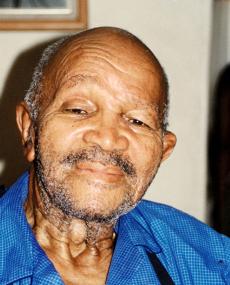
Mnyaluza Pemba was born on 2 April 1912 at Hill’s Kraal in Korsten, Port Elizabeth. Although art classes were not offered at the Van der Kemp Mission Primary School where he was educated, Pemba developed an early love for art which his father encouraged by buying him pencils and crayons. The young Pemba became notorious for escaping from the drudgery of schoolwork into his private world of drawing.
In 1924, Pemba won a Grey Scholarship to Paterson School, where he devoured the art books in the school library. As a 16 year old pupil, he entered and won an art competition at a local agricultural show. Pemba began to expand his repertoire to include drawing portraits based on photographs, for which he earned pocket-money.
 Figure 2. Nonquase, 1985. Source: vgallery.co.za
Figure 2. Nonquase, 1985. Source: vgallery.co.za
He continued to pursue his art successfully over the next six decades. His exquisite paintings and drawings slowly began to attract a wider audience and led to his exhibiting more widely. After his works were accepted for an exhibition of “Negro and Bantu Art” in Port Elizabeth in the late 1930s, Pemba exhibited regularly (until shortly before his death in 2001).
Pemba turned professional in the late 1940s, and entirely against the tide of the growing threat of overt racism engulfing South African society, held his first solo exhibition in East London in 1948. Pemba’s successful exhibition and the sale of his paintings, at the Eastern Province Art Association’s annual exhibition in 1965, provoked undisguised racial hostility.
Despite indifference from the mainstream art world which regarded his work at best as colloquial, and antipathy from the apartheid government which, given the pre-ordained prescriptions of the Apartheid ideology, saw his profession as inappropriate for a ‘native’, Pemba persevered with his work thanks to the support of a few patrons, and his wife Eunice who helped to supplement his income by running a ‘house shop’.
 Figure 3. Terror, 1991. Source: artthrob.co.za
Figure 3. Terror, 1991. Source: artthrob.co.za
In the last few years of his life, this great pioneering South African artist, who in 1944 wrote that “I do not know if ever I will become a great artist, but an artist of my own nation I surely am to be”¦”, received belated recognition from the art world and South Africans at large.
His artistic talent – reflected in the body of work he has left to posterity - and his dogged determination to express himself as a black artist despite the odds, mark him as a South African who shall be remembered and admired for all time.
Pemba, was also a writer of note, and penned at least two plays known to have been staged. He was later awarded with an honorary Masters’ Degree from University of Fort Hare in 1979 for his contribution to South African art.
The South African Government bestowed George Pemba with the Order of Ikhamanga in Gold at the National Orders awards on 19 October 2004, for his pioneering and exceptional contribution to the development of the art of painting and literature.